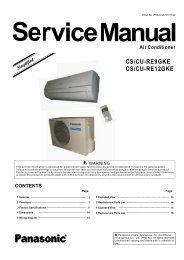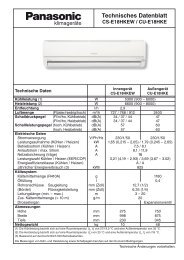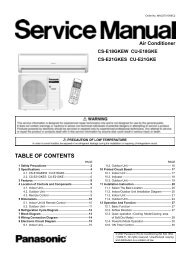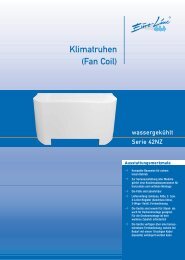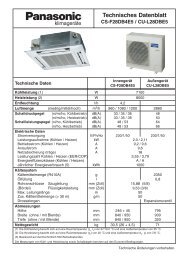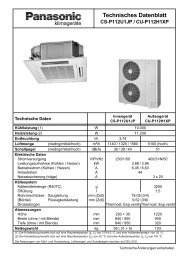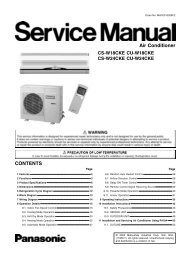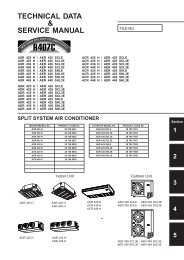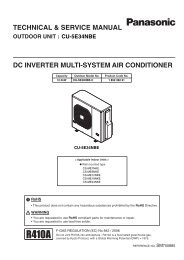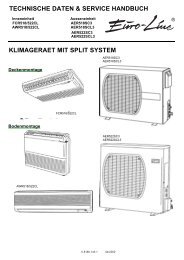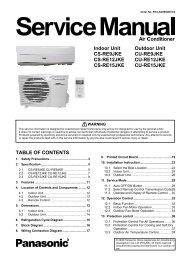technical data & service manual split system air conditioner
technical data & service manual split system air conditioner
technical data & service manual split system air conditioner
You also want an ePaper? Increase the reach of your titles
YUMPU automatically turns print PDFs into web optimized ePapers that Google loves.
IMPORTANT!<br />
Please read before installation<br />
This <strong>air</strong> conditioning <strong>system</strong> meets strict safety and operating<br />
standards.<br />
For the installer or <strong>service</strong> person, it is important to install or<br />
<strong>service</strong> the <strong>system</strong> so that it operates safely and efficiently.<br />
For safe installation and trouble-free operation, you must:<br />
• Carefully read this instruction booklet before beginning.<br />
• Follow each installation or rep<strong>air</strong> step exactly as shown.<br />
• Observe all local, state and national electrical codes.<br />
• Pay close attention to all warning and caution notices given in<br />
this <strong>manual</strong>.<br />
•The unit must be supplied with a dedicated electrical line.<br />
WARNING<br />
This symbol refers to a hazard or unsafe practice which can result<br />
in severe personal injury or death.<br />
CAUTION<br />
This symbol refers to a hazard or unsafe practice which can result<br />
in personal injury or product or property damage.<br />
If necessary, get help<br />
These instructions are all you need for most installation sites and<br />
maintenance conditions.<br />
If you require help for a special problem, contact our sale/<strong>service</strong><br />
outlet or your certified dealer for additional instructions.<br />
In case of improper installation<br />
The manufacturer shall in no way be responsible for improper<br />
installation or maintenance <strong>service</strong>, including failure to follow the<br />
instructions in this document.<br />
SPECIAL PRECAUTIONS<br />
• During installation, connect before the refrigerant <strong>system</strong> and<br />
then the wiring one; proceed in the reverse orden when removing<br />
the units.<br />
WARNING When wiring<br />
ELECTRICAL SHOCK CAN CAUSE SEVERE<br />
PERSONAL INJURY OR DEATH. ONLY A QUALIFIED,<br />
EXPERIENCED ELECTRICIANS SHOULD ATTEMPT<br />
TO WIRE THIS SYSTEM.<br />
• Do not supply power to the unit until all wiring and tubing are<br />
completed or reconnected and checked, to ensure the grounding.<br />
• Highly dangerous electrical voltages are used in this <strong>system</strong>.<br />
Carefully refer to the wiring diagram and these instructions when<br />
wiring.<br />
Improper connections and inadequate grounding can cause<br />
accidental injury and death.<br />
2<br />
• Ground the unit following local electrical codes.<br />
• The Yellow/Green wire cannot be used for any connection<br />
different from the ground connection.<br />
• Connect all wiring tightly. Loose wiring may cause overheating<br />
at connection points and a possible fire hazard.<br />
• Do not allow wiring to touch the refrigerant tubing, compressor,<br />
or any moving parts of the fan.<br />
• Do not use multi-core cable when wiring the power supply and<br />
control lines. Use separate cables for each type of line.<br />
When transporting<br />
Be careful when picking up and moving the indoor and outdoor<br />
units. Get a partner to help, and bend your knees when lifting to<br />
reduce strain on your back. Sharp edges or thin aluminium fins on<br />
the <strong>air</strong> <strong>conditioner</strong> can cut your fingers.<br />
When installing...<br />
... In a ceiling or wall<br />
Make sure the ceiling/wall is strong enough to hold the unit-weight.<br />
It may be necessary to build a strong wooden or metal frame to<br />
provide added support.<br />
... In a room<br />
Properly insulate any tubing run inside a room to prevent<br />
"sweating", which can cause dripping and water damage to walls<br />
and floors.<br />
... In moist or uneven locations<br />
Use a raised concrete base to provide a solid level foundation for<br />
the outdoor unit.<br />
This prevents damage and abnormal vibrations.<br />
... In area with strong winds<br />
Securely anchor the outdoor unit down with bolts and a metal<br />
frame. Provide a suitable <strong>air</strong> baffle.<br />
... In a snowy area (for heat pump-type <strong>system</strong>s)<br />
Install the outdoor unit on a raised platform that is higher than<br />
drifting snow. Provide snow vents.<br />
When connecting refrigerant tubing<br />
• Keep all tubing runs as short as possible.<br />
• Use the flare method for connecting tubing.<br />
• Apply refrigerant lubricant to the matching surfaces of the flare<br />
and union tubes before connecting them; screw by hand and<br />
then tighten the nut with a torque wrench for a leak-free<br />
connection.<br />
• Check carefully for leaks before starting the test run.<br />
NOTE:<br />
Depending on the <strong>system</strong> type, liquid and gas lines may be either<br />
narrow or wide. Therefore, to avoid confusion, the refrigerant<br />
tubing for your particular model is specified as narrow tube for<br />
liquid, wide tube for gas.<br />
When servicing<br />
• Turn the power OFF at the main power board before opening<br />
the unit to check or rep<strong>air</strong> electrical parts and wiring.<br />
• Keep your fingers and clothing away from any moving parts.<br />
• Clean up the site after the work, remembering to check that no<br />
metal scraps or bits of wiring have been left inside the unit being<br />
<strong>service</strong>d.<br />
• Ventilate the room during the installation or testng the refrigeration<br />
<strong>system</strong>; make sure that, after the installation, no gas leaks are<br />
present, because this could produce toxic gas and dangerous<br />
if in contact with flames or heat-sources.



